t+1/2Vx Continue reading
The above expression is the actuarial depiction of a “mean reserve” for a life insurance policy. The age at issue is x, and, if I remember correctly, the number of elapsed years is t. V is the symbol for reserve. The +1/2 indicates that it is valuated halfway through the year. Thus, it is the “mean” (average) reserve value for the year.
 The Hartford Life hired four young men as actuarial students in 1972. Because of my time in the Army, I was the oldest and the last one hired. The other three were all recent college graduates, and they were all named Tom: Corcoran, Garabedian, and Herget. The three of them shared more than the name Tom; they were all quite interested in sports (especially baseball and basketball), and they were all pretty good athletes as well.
The Hartford Life hired four young men as actuarial students in 1972. Because of my time in the Army, I was the oldest and the last one hired. The other three were all recent college graduates, and they were all named Tom: Corcoran, Garabedian, and Herget. The three of them shared more than the name Tom; they were all quite interested in sports (especially baseball and basketball), and they were all pretty good athletes as well.
I was almost as interested in sports as they were, but my baseball (documented here) and basketball (documented here) careers were not exactly sterling. Besides, my favorite sport has always been football, and my biggest passion was college football, which was almost unknown in New England—at the time Boston College was the only school in New England that played in the top division, as opposed to five in the state of Michigan alone.
 Tom Corcoran1 was a recent graduate of Brown. He grew up in Stoneham, a suburb on the north side of Boston. He was a die-hard fan of the Sawx and the Celtics. He also played for the rugby club at Brown. Tom was strong, and he knew a lot about basketball, or at least a lot more than I did.
Tom Corcoran1 was a recent graduate of Brown. He grew up in Stoneham, a suburb on the north side of Boston. He was a die-hard fan of the Sawx and the Celtics. He also played for the rugby club at Brown. Tom was strong, and he knew a lot about basketball, or at least a lot more than I did.
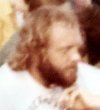 Tom Herget2 was from Aurora, IL, west of Chicago. He had just graduated from the University of Illinois, where he majored in parties and minored in math. Tom had uncanny success in basketball with his devious moves near the basket. He was without a doubt the friendliest guy whom I have ever met. He also often made Jack Benny look like a big spender.
Tom Herget2 was from Aurora, IL, west of Chicago. He had just graduated from the University of Illinois, where he majored in parties and minored in math. Tom had uncanny success in basketball with his devious moves near the basket. He was without a doubt the friendliest guy whom I have ever met. He also often made Jack Benny look like a big spender.
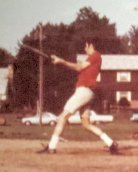 Tom Garabedian3, a graduate of Bowdoin College in Maine, lived within walking distance of my apartment in East Hartford. Tom was a skillful ball handler and very quick. He was often asked to defend the opponent’s best scorer, even those who were six or more inches taller.
Tom Garabedian3, a graduate of Bowdoin College in Maine, lived within walking distance of my apartment in East Hartford. Tom was a skillful ball handler and very quick. He was often asked to defend the opponent’s best scorer, even those who were six or more inches taller.
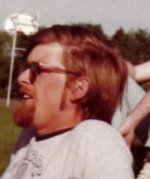 At some point in the summer we were joined by John Sigler, who was a year or two older than I was. He transferred to Life Actuarial from the Data Processing Department. John graduated from the University of South Carolina. His favorite sport was golf, and he was very good at it. We played golf together a lot. More details are provided here. His basketball game was about on a par with mine.
At some point in the summer we were joined by John Sigler, who was a year or two older than I was. He transferred to Life Actuarial from the Data Processing Department. John graduated from the University of South Carolina. His favorite sport was golf, and he was very good at it. We played golf together a lot. More details are provided here. His basketball game was about on a par with mine.
By the end of the summer the five of us knew each other pretty well. I had not worked with any of them but Tom C., Tom H., John, and I were on the twenty-first floor, and we usually ate lunch together. Tom G. worked in the Group Department, but we all knew him pretty well.
Tom Herget, who had quickly made friends with many people in both buildings, somehow learned that the Hartford was sponsoring a basketball league. He decided to put together a team. He recruited all five of us along with a handful of other guys. The ones that I remember were:
- Kevin Kirk, the only non-actuary on the team, worked in the Individual Pensions Department. He was a point guard on his college team at Belmont Abbey, a small college in North Carolina.
- Jan Pollnow was one of the very best players in the company. He went to the University of Wisconsin.
- Fred Smith was a big strong guy who was a force under the boards.
- Frank Lord was an actuarial student who had attended Dartmouth. His best sport was tennis.
I am quite sure that there was at least one more player for our first game. I distinctly remember that we had ten players. Maybe Mike Winterfield played. In 1973-74 Jim Cochran, who came from Wisconsin, played as well.
The games were old school—there was no three-point line. None of the teams had uniforms. However, we did have real refs, and they did not swallow their whistles. I was once called for a technical foul when I emoted the word “Geez” after an opposing player who was dribbling with his right hand karate chopped me with his left. On the other hand, several charging fouls were called on opposing players who sent me flying with incidental contact on drives to the basket. I wasn’t flopping. These guys were husky, and I was a reed with a high center of gravity.
I think that it was Tom H. who came up with the name “Mean Reserves”. It was a brilliantly wonky idea. He also supplied a few of us with “warmup jackets”, which were actually shirts evidently abandoned at the dry cleaners by an unidentified auto service place. Tom bought them for a buck or two. The other two Toms got one with “Rocco” embroidered over one pocket. Mine said “Neal”. Tom got one for himself as well, but it was anonymous. We wore them faithfully to the games. I am sure that our opponents were impressed.
The aptness of the team’s name was demonstrated in the first game, which, like all the others was played at Northwest Catholic High School in West Hartford. We played against five guys who were in their thirties or forties. We pressed the entire game, and we played two platoons who relieved each other every five or ten minutes. We had to lay off a bit in the second half. The opponents were so winded that they were nearly ready to quit (or maybe die).
 We had pretty good teams both years. We won a lot more often than we lost. After each victory most of us would gather for pizza and beer at The Keg,4 a restaurant/bar on Sisson Avenue. We might have gone there when we lost, too. We did not need much of an excuse to keep the party going.
We had pretty good teams both years. We won a lot more often than we lost. After each victory most of us would gather for pizza and beer at The Keg,4 a restaurant/bar on Sisson Avenue. We might have gone there when we lost, too. We did not need much of an excuse to keep the party going.
In both years the best team in the league was the one representing the company’s Mailroom. One of their guys was by far the best player in the league. He towered over everyone, and he could consistently hit jump shots from the top of the key. We put Garabedian on him, and that helped, but if he ever got the ball near his spot, the scorekeeper could just record two points without looking.
I remember once that we were scheduled to play the Mailroom, and with a minute or two left in the warmup time, only three of their guys had shown up. Just a few seconds before they would have had to forfeit, two or three more guys appeared and played the whole game in blue jeans.
I also remember that one guy from the Mailroom was not very tall and was quite portly. We figured him for the weak link, but we were wrong. Not only could he dribble and shoot, but he could really jump, and he was also in pretty good shape.
I think that I showed up for every game, but I was seldom much of a factor. I only have one other vivid memory. We were scheduled to play a good team from (I think) Operations Research. They had two really good players, a ball-handler whose name I don’t remember, and a scoring machine whose last name was Kolodziej.
We were shorthanded. Jan Pollnow and Fred Smith did not play. Tom Corcoran was pressed into playing center, and I played most of the game at one of the forwards. Tom said that we should play a zone defense and told me that my responsibility was to keep Kolodziej from going “back-door.” Seeing the blank expression on my face, he explained that when Kolodziej got the ball on my side to let him go and to stand next to the out-of-bounds line between him and the basket so that he could not drive past me under the basket. To drive to the basket he would need to go where the guards could help defend him. To my astonishment this strategy worked.
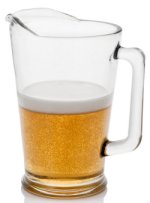 We all played our best game, and we proved that we could win without Jan. This was the only time in my life that I ever played more than half of an official basketball game that was won by my team. The beer and pizza tasted very good that night.
We all played our best game, and we proved that we could win without Jan. This was the only time in my life that I ever played more than half of an official basketball game that was won by my team. The beer and pizza tasted very good that night.
I do not have any paperwork or photos for the basketball games, and my memory is faulty. Sorry.
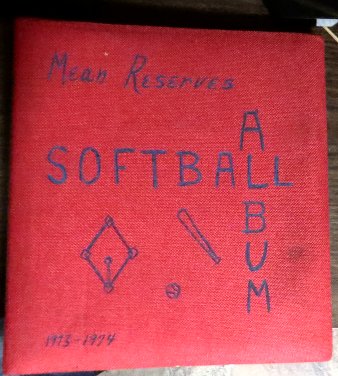 Fortunately, I have a treasure trove of information and photos for the softball teams. Sue Comparetto5 and I put together an album documenting the first two years of the Mean Reserves softball team. Here is the introduction to that tome.
Fortunately, I have a treasure trove of information and photos for the softball teams. Sue Comparetto5 and I put together an album documenting the first two years of the Mean Reserves softball team. Here is the introduction to that tome.
Spring 1973 found the weekday residents of the twenty-first floor tired but restive after their first successful basketball season. A memorandum was circulated by the Men’s Club announcing the organization of a softball league for that summer. The whole floor responded with the usual enthusiasm to such memos, but basketball captain R. T. “Tom” Herget happened to read the memo before throwing it away, and, remembering his old mushball days in Illinois, he decided to try to organize an entry.
A typical reaction to Tom’s recruiting was Kevin Kirk’s “What?” Paul Gewirtz thought that a softball game was played with a Nerf ball and a hoop. Eventually, however, enough “players” responded to form an all-volunteer team!
The first thing that the team needed was a name. Tom remembered the stories that used to be passed around on LaSalle St.6 about the legendary T. V. “Mean” Reserve. Mean passed up a promising career as a relief pitcher for Eddie Feigner’s King and His Court softball team to pursue a lifelong ambition of correlating the five-step delivery with mortality among professional bowlers. “Just the thing to inspire the team to greatness”, thought Tom, but his suggestion that the team be known as the TV’s was rejected, and we were stuck with the same name as the basketball team’s—the Mean Reserves.
Slow-pitch softball uses the standard ball that is twelve inches in circumference. Each team has ten players in the field. The extra player usually plays in the outfield. Pitches must be underhand with an arc of between three and ten feet. Bunting was not allowed. Leadoffs and stealing of bases were also verboten.
Everyone who played on the basketball teams also played softball. The following guys also joined us in 1973:
- Jim Cochran, who also played on the basketball squad later in the year, led the team in hitting with a .538 average, in 1973.
- Wayne Foster, who ran the payday pool, was the only Vietnam veteran (that I know of) on the twenty-first floor. he told me that he was awarded a Bronze Star for putting through an international phone call for the guy who maintained the list. He played first base.
- Charley Robinson from the Special Risk Underwriting Department played in about half of the games.
 Scott Otermat7, who went to Oberlin College and was my supervisor in the Individual Pensions Department, shared pitching duties with Frank Lord and me.
Scott Otermat7, who went to Oberlin College and was my supervisor in the Individual Pensions Department, shared pitching duties with Frank Lord and me.- Ron Wittenwiler was a very good third baseman, but he only came to a couple. of games.
- Les Gubkin also played in a couple of games. I remember him, but not where he worked.
- Mike Swiecicki8 was a very athletic actuarial student, but he only played softball once or twice.
- Paul Gewirtz bought his first baseball glove before showing up for one game. He played more in ’74. His defensive play was, well, noteworthy.
- Paul Engstrom was a good enough fielder to play shortstop. He also was a bigger factor in ’74.
We did not actually win any games in 1973, but we made the playoffs anyway. We were eliminated in the first round.
Achievements: Tom Corcoran had eight RBI’s. Tom Garabedian scored eight runs. I led the team in hits and at-bats and was second in both runs and RBI’s.
In 1974 (the rebuilding year) even more people played:
- Bob Riley was a Rock at first base
- Don Sondergeld had only one official at-bat, but he appeared in quite a few of Sue’s photos.
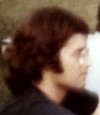 Jim Hawke, often called “Hawkeye” in tribute to his thick glasses, held a masters degree in math from UConn. He also played a really hot ragtime piano. You have probably heard of his son Ethan, the famous actor.
Jim Hawke, often called “Hawkeye” in tribute to his thick glasses, held a masters degree in math from UConn. He also played a really hot ragtime piano. You have probably heard of his son Ethan, the famous actor.- Mike Wheeler played in several games, but I don’t remember him at all.
- Lou Aiello only batted twice, but he got one hit and one RBI that no one will ever forget.
- Jim Housholder only batted once.
- Keith Reynolds was a fast runner who could cover a lot of ground in the outfield. He worked on another floor.
- Paul Campbell, was hired as a Variable Annuity actuary in the middle of the season.
- David Rowe was an exchange actuary from England. He had one hit in four at-bats. He might have done better, but he sometimes ran to third base when he hit the ball. We also had to keep reminding him not to carry the bat on the base paths.
Achievements: Tom Corcoran was again the star of the team with twenty-four hits, nineteen runs, twenty RBI’s, three triples, and four legitimate home runs. He also was our best outfielder. He actually gunned down a few overly ambitious base runners.
I led the team (and the league) in hitting with a .720 average. I also hit one comical home run.
Over the two years I had 33 hits in 54 at-bats. This was quite a change for the guy who only hit the ball once in his first entire season. How did I do it? Well, there were several important factors.
-
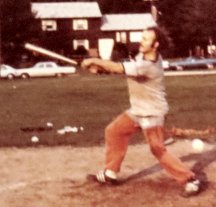
No, Tom H. is not left-handed. I included this photo to show my heavy aluminum bat. The street in the background is the one that aided my home run.
I had bought a very heavy aluminum bat, which I still have. No one else could stand to use it.
- I stood at least two feet away from home plate and towards the front of the batter’s box. When the ball came over the plate it was outside and slightly behind me.
- After I entered the batters box, look longingly toward left field and then point the bat in that direction. Often this charade would induce the right fielder and the short fielder to take several steps to their right.
- The right fielder was usually the team’s second-worst fielder (after the catcher).
- I concentrated on hitting the bottom center of the ball while stepping toward right field. This swing always imparted left-to-right (slice) spin to the ball.
I only made seven outs in 1974. Three or four of them came in one frustrating game in which the opposing pitcher threw the ball with the back of his hand toward the plate. This put backspin on the pitches. My swing usually produced soft line drives between first and second. In that one game, however, I was able to hit nothing but ground balls and weak pop-ups.
I tried to emulate his technique in pitching practice, but I could not consistently throw strikes. I don’t think that I would ever be able to master it.
Memorable events: We won a game! I don’t remember which team we beat, but Frank Lord was the winning pitcher. We made the playoffs again. This time we lost by only 8-6 to the Staggers, the top-seeded team. It was easily our best game. The explanation is here.
Here is how I hit a triple and a home run. In both cases I hit soft line drives over the first baseman’s head. When the ball hit the ground it made a right turn because my swing always produced a slice. In the first case I was standing on third by the time that the ball made it to the infield. In the other case the ball made it to the street, which sloped rather sharply away from the infield. The ball actually was picking up speed when the right fielder picked it up. I was crossing the plate as the ball reached the first baseman.
No one who was present will ever forget Lou Aiello’s RBI single. Lou had not played a lot of baseball. His other at-bat for the Mean Reserves was a strikeout, which is almost unheard of in slow-pitch softball. It is important to note a few things that provide context for his successful plate appearance.
-
- Many pitchers backed up three or four steps as soon as they released the ball.
- Most teams put their worst defensive player at catcher.
- Catchers never crowded the plate. They generally stood several feet back and fielded pitches on one bounce if they fielded them at all.
- As I mentioned, both bunting and base-stealing were illegal.
</ol
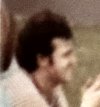 On his second at-bat Lou swung and missed a couple of times. The crowd shouted encouragement. Lou then connected, but just barely—the bottom of his bat grazed the top of the ball, causing it to roll to a stop a few feet in front of home plate. The Mean Reserve bench erupted with “Run, Lou, run!” The catcher was stupefied, and the pitcher was slow enough charging back in to get the ball that Lou had reached first base before the throw. Meanwhile, the Mean Reserve who had been on third scored easily because the catcher was still confused and made no move to defend home plate.
On his second at-bat Lou swung and missed a couple of times. The crowd shouted encouragement. Lou then connected, but just barely—the bottom of his bat grazed the top of the ball, causing it to roll to a stop a few feet in front of home plate. The Mean Reserve bench erupted with “Run, Lou, run!” The catcher was stupefied, and the pitcher was slow enough charging back in to get the ball that Lou had reached first base before the throw. Meanwhile, the Mean Reserve who had been on third scored easily because the catcher was still confused and made no move to defend home plate.
This episode goes down in the Mean Reserve annals as “Lou Aiello’s Swinging Bunt”.
-
- I had a close-up view of the other memorable occasion. I was playing first base, and Paul Gewirtz was playing second. Paul, who was left-handed, had never played baseball before. When he was purchasing his baseball glove he argued with the salesman who had told him that he wanted one for his right hand, which theretofore, had never done much useful for him. “You don’t want this big mitt on the hand that you throw with!”
So, yes, we occasionally had a left-handed second baseman. You won’t see one in the majors, but then again, the Mean Reserves did not turn many double plays. We put Paul at second base because the vast majority of infield balls are hit to the other side of the field.
In this game, however, someone hit a rather sharp grounder almost right at Paul. Instinct took over, and Paul reached down to catch the ball with his bare left hand rather than his gloved right hand. He did a good job of stopping the ball, and so I moved over to first base and positioned myself to catch his throw.
To everyone’s surprise Paul did not pick the ball up and throw it to me. Instead, leaving the ball in the base path, he turned and purposefully jogged into right field. I hurried over to get the ball. I barely beat the pitcher and shortstop there, and I reached for the ball. Meanwhile, the hitter had rounded first and run past the three of us. When I picked up the ball, there were no Mean Reserves near second base. So, the hitter got a really cheap double.
-
- When we finally retired the side, I grabbed a beer from the cooler and then took Paul aside to ask him why he had run out to right field after he stopped the ball. He explained that he thought that the ball had
knocked his thumb off
-
- , and he went out to retrieve it.
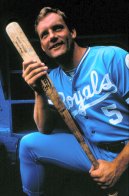 I swear on George Brett’s pine-tar bat that this is a true story.
I swear on George Brett’s pine-tar bat that this is a true story.
1. Tom Corcoran married Patti Lewonczyk from the Individual Pensions Department. He still has a house in Wethersfield, CT, but he also has an apartment in Burlington, VT, where both of his children, Brian and Casey, and their families reside.
2. In 2021 Tom Herget and his wife live in his home town of Aurora, IL. He sends me a Christmas card every December.
3. In 2021 Tom Garabedian is living in the Boston are.
4. The family that owned The Keg moved the operation to Farmington in 2002. The Hartford Courant covered that event here. The building at 99 Sisson Avenue is now a Wood N Tap restaurant.
5. Much more information about Sue can be found here.
6. The headquarters of the Society of Actuaries was on LaSalle St. in Chicago. It subsequently moved to the suburb of Schaumburg.
7. Scott Otermat left the Hartford in 1980. He died in 2016. His obituary is here.
8. Mike Swiecicki left the Hartford before I did. He died in 2015 after a twenty-five year career as an actuary with CAL PERS. His obituary is here.

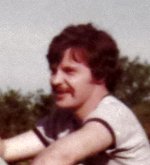


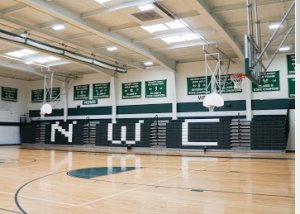
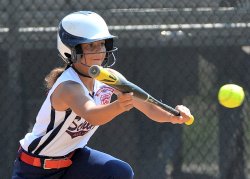
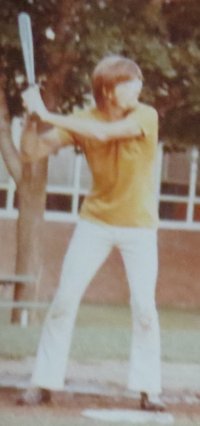
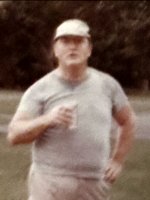
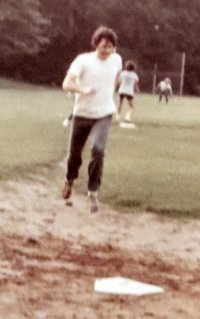
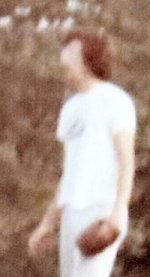
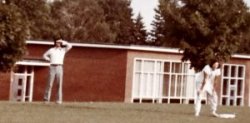
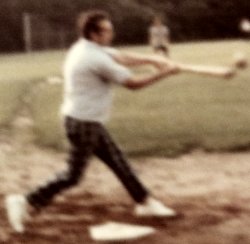

Pingback: 1972-1974 Connecticut: Sports | Wavablog
Pingback: 1972-1974 Connecticut: Social Life Draft | Wavablog
Pingback: 2013-2017 Members of the Simsbury Bridge Club Part 2 | Wavablog